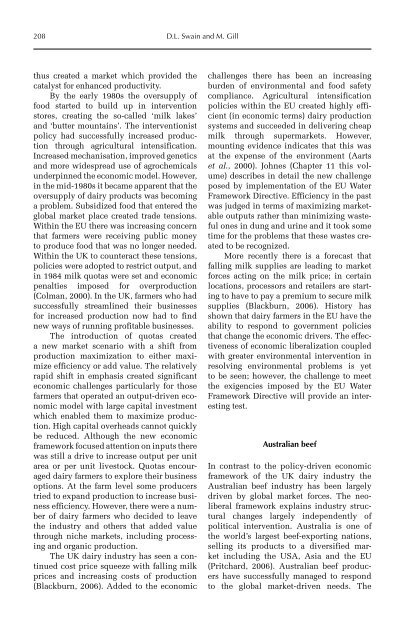Redesigning Animal Agriculture
Redesigning Animal Agriculture
Redesigning Animal Agriculture
Create successful ePaper yourself
Turn your PDF publications into a flip-book with our unique Google optimized e-Paper software.
208 D.L. Swain and M. Gill<br />
thus created a market which provided the<br />
catalyst for enhanced productivity.<br />
By the early 1980s the oversupply of<br />
food started to build up in intervention<br />
stores, creating the so-called ‘milk lakes’<br />
and ‘butter mountains’. The interventionist<br />
policy had successfully increased production<br />
through agricultural intensification.<br />
Increased mechanisation, improved genetics<br />
and more widespread use of agrochemicals<br />
underpinned the economic model. However,<br />
in the mid-1980s it became apparent that the<br />
oversupply of dairy products was becoming<br />
a problem. Subsidized food that entered the<br />
global market place created trade tensions.<br />
Within the EU there was increasing concern<br />
that farmers were receiving public money<br />
to produce food that was no longer needed.<br />
Within the UK to counteract these tensions,<br />
policies were adopted to restrict output, and<br />
in 1984 milk quotas were set and economic<br />
penalties imposed for overproduction<br />
(Colman, 2000). In the UK, farmers who had<br />
successfully streamlined their businesses<br />
for increased production now had to find<br />
new ways of running profitable businesses.<br />
The introduction of quotas created<br />
a new market scenario with a shift from<br />
production maximization to either maximize<br />
efficiency or add value. The relatively<br />
rapid shift in emphasis created significant<br />
economic challenges particularly for those<br />
farmers that operated an output-driven economic<br />
model with large capital investment<br />
which enabled them to maximize production.<br />
High capital overheads cannot quickly<br />
be reduced. Although the new economic<br />
framework focused attention on inputs there<br />
was still a drive to increase output per unit<br />
area or per unit livestock. Quotas encouraged<br />
dairy farmers to explore their business<br />
options. At the farm level some producers<br />
tried to expand production to increase business<br />
efficiency. However, there were a number<br />
of dairy farmers who decided to leave<br />
the industry and others that added value<br />
through niche markets, including processing<br />
and organic production.<br />
The UK dairy industry has seen a continued<br />
cost price squeeze with falling milk<br />
prices and increasing costs of production<br />
(Blackburn, 2006). Added to the economic<br />
challenges there has been an increasing<br />
burden of environmental and food safety<br />
compliance. Agricultural intensification<br />
policies within the EU created highly efficient<br />
(in economic terms) dairy production<br />
systems and succeeded in delivering cheap<br />
milk through supermarkets. However,<br />
mounting evidence indicates that this was<br />
at the expense of the environment (Aarts<br />
et al., 2000). Johnes (Chapter 11 this volume)<br />
describes in detail the new challenge<br />
posed by implementation of the EU Water<br />
Framework Directive. Efficiency in the past<br />
was judged in terms of maximizing marketable<br />
outputs rather than minimizing wasteful<br />
ones in dung and urine and it took some<br />
time for the problems that these wastes created<br />
to be recognized.<br />
More recently there is a forecast that<br />
falling milk supplies are leading to market<br />
forces acting on the milk price; in certain<br />
locations, processors and retailers are starting<br />
to have to pay a premium to secure milk<br />
supplies (Blackburn, 2006). History has<br />
shown that dairy farmers in the EU have the<br />
ability to respond to government policies<br />
that change the economic drivers. The effectiveness<br />
of economic liberalization coupled<br />
with greater environmental intervention in<br />
resolving environmental problems is yet<br />
to be seen; however, the challenge to meet<br />
the exigencies imposed by the EU Water<br />
Framework Directive will provide an interesting<br />
test.<br />
Australian beef<br />
In contrast to the policy-driven economic<br />
framework of the UK dairy industry the<br />
Australian beef industry has been largely<br />
driven by global market forces. The neoliberal<br />
framework explains industry structural<br />
changes largely independently of<br />
political intervention. Australia is one of<br />
the world’s largest beef-exporting nations,<br />
selling its products to a diversified market<br />
including the USA, Asia and the EU<br />
(Pritchard, 2006). Australian beef producers<br />
have successfully managed to respond<br />
to the global market-driven needs. The










